May 20, 2025 | 15:41 GMT +7
May 20, 2025 | 15:41 GMT +7
Hotline: 0913.378.918
May 20, 2025 | 15:41 GMT +7
Hotline: 0913.378.918
According to Nguyen Tung Phong, Director of the Department of Water Resources (Ministry of Agriculture and Rural Development), Typhoon Yagi hitting the North caused unimaginable heavy rain at the end of the flood season, making it a very sensitive and dangerous situation.
Previously on September 3, irrigation reservoirs in the Northern region were allowed to accumulate water to the normal water level in service of production. The reservoir capacity reached 80 - 90% of the design capacity since the Northern region was at the end of the flood season. The flood prevention capacity of the reservoirs is very small. Without proactiveness and effective operation, the risk of unsafe incidents is very high.
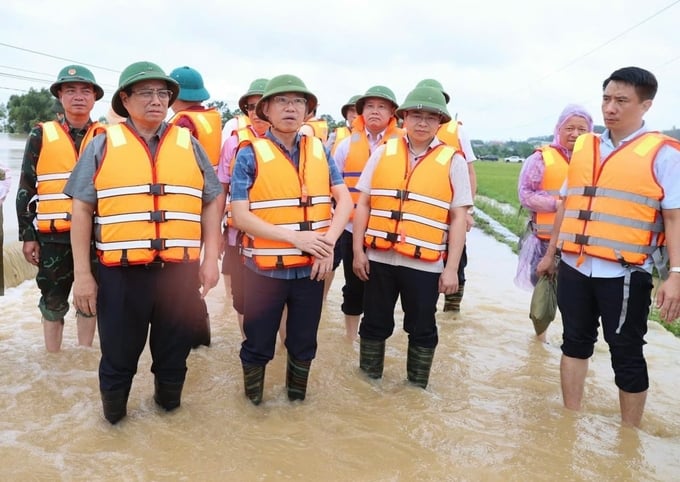
Prime Minister Pham Minh Chinh inspects flood prevention and control work in Bac Giang on September 10. Photo: Dong Thai.
Statistics show that before the floods post Typhoon Yagi even appeared, the Northern region and Thanh Hoa province had a total of 3,153 lakes, of which 143 were severely damaged. Only 23 lakes had spillways that could lower the water level to receive floods, the remaining 3,149 lakes had free spillways and could not lower the water level to receive floods. The lakes lacked specialized hydrometeorological monitoring equipment, such as automatic rain gauges in the basin, automatic lake water level gauges, and operational observation equipment.
Considering the severity of the situation, the Department of Water Resources has proactively issued documents requesting localities and units to ensure the safety of irrigation works, coordinate with scientific units under the Ministry to strengthen monitoring of information, developments of floods and water sources. The aim is to come up with solutions and give advice on the operation of reservoirs, thereby ensuring the safety of irrigation works, downstream areas of dams and storing water for production and people's lives.
Exceeding the forecast data of the hydrometeorological sector, heavy rains have caused historic floods in many provinces and cities in the Northern region and Thanh Hoa. The total rainfall from September 6 - 11, 2024 is commonly 250 - 350 mm and 350 - 450 mm in mountainous areas. Some stations even recorded heavy rain such as Nam Xay Luong (Lao Cai) 760 mm, Nam Dan 2 (Ha Giang) 710 mm, Tien Hai (Thai Binh) 680 mm, Cho Chu (Thai Nguyen) 666 mm, and Thuong Tin (Hanoi) 609 mm.
At many times, upstream floods flow into reservoirs with a flow rate much larger than the discharge capacity of the works. Thanks to the flexible direction and reservoir operations, irrigation reservoirs not only stand firm but also contribute to flood control and flood reduction for downstream areas.
The work under the greatest pressure is probably Cam Son discharge lake (Bac Giang). With a basin area of over 378 km2 (the eighth largest in the country), the main dam is 41.5m high and 230 m long. If the lake has any problems, the downstream areas of Luc Ngan, Lang Giang, Yen Dung districts, Bac Giang city (Bac Giang) and Huu Lung district (Lang Son) would suffer severe damage.
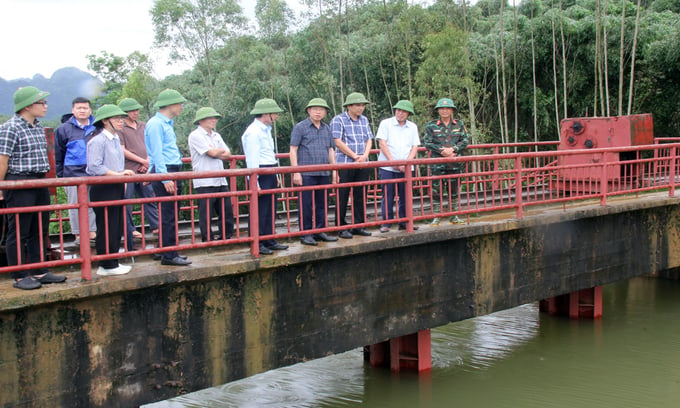
The water level of Cam Son discharge lake rose on September 9, 2024, due to the impact of Typhoon No. 3 resulting in floods. Photo: Dong Thai.
The nerve-wracking situation appears: If Cam Son reservoir releases floodwaters at maximum capacity while the water level of the Thuong river downstream exceeds alert level 3, it will endanger the dike system and the property and lives of people downstream. If the water is released slowly, there is a risk of an incident occurring at the reservoir if the flood situation becomes complicated.
“We had many sleepless nights, constantly discussing with the Bac Song Thuong Irrigation Works Exploitation Company (the unit operating and exploiting Cam Son discharge lake) to update the forecast of hydrometeorology and water flow to regulate operations at the lake. Fortunately, Cam Son discharge lake is equipped with a modern hydrometeorology monitoring system, so it can forecast the flood situation quite accurately. In 7 days (from September 6 to 12), the total flow to the lake reached 144 million m3, the flood peak reached more than 2,700 m3/s, but Cam Son discharge lake only discharged 137 m3/s at max, retaining 62 million m3 of water (from September 6 to 8). Reasonable lake operation helps cut and reduce floods for downstream areas,” said Nguyen Tung Phong.
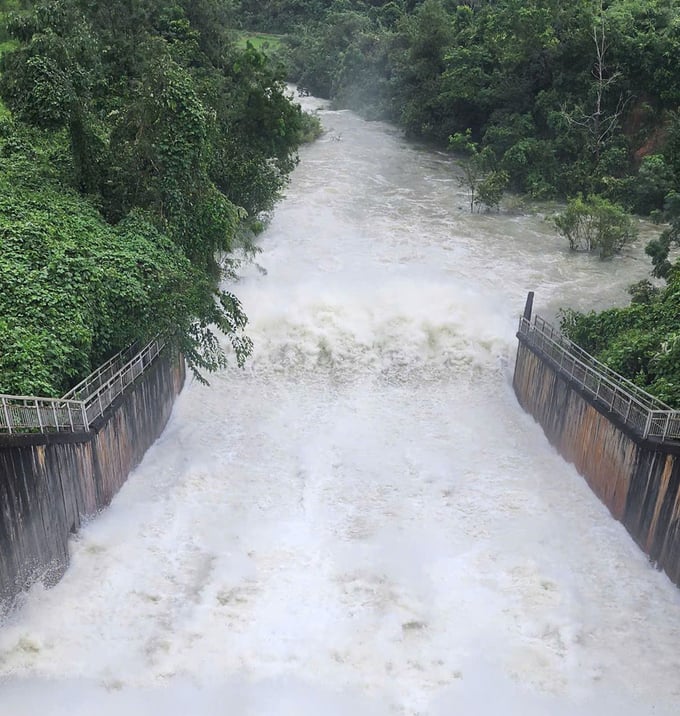
Cam Son discharge lake releases water to reduce pressure on the lake bed. Photo: Dong Thai.
Through monitoring, it can be seen that large reservoirs with flood control gates operate in accordance with approved procedures, fulfilling their role in cutting floods downstream. During and after the storm, no reservoirs encounter major problems. Only a few reservoirs are damaged to a minor extent, which does not affect the safety of the work and does not have any immediate impact on downstream areas.
According to Director of the Department of Water Resources Nguyen Tung Phong, one of the tasks that the irrigation sector needs to focus on in the near future is to install monitoring stations (rain, flow, water level, etc.), apply calculation software, and support decision making to operate reservoirs.
It is necessary to review the reservoir operation process specifically large reservoirs with gates for operation in order to ensure the safety of the works, the downstream area of the dam and store maximum water for production. The Northern region currently has 143 severely damaged reservoirs without funding for repair, mainly medium and small reservoirs.

Nguyen Tung Phong, Director of the Department of Water Resources (Ministry of Agriculture and Rural Development). Photo: Quynh Chi.
“In the context of climate change, dangerous natural disasters are becoming more extreme and more difficult to predict. Therefore, investing in upgrading, repairing, ensuring dam safety and applying science and technology to serve hydrometeorological forecasting and system operation is becoming increasingly important,” said Director Nguyen Tung Phong.
Translated by Samuel Pham
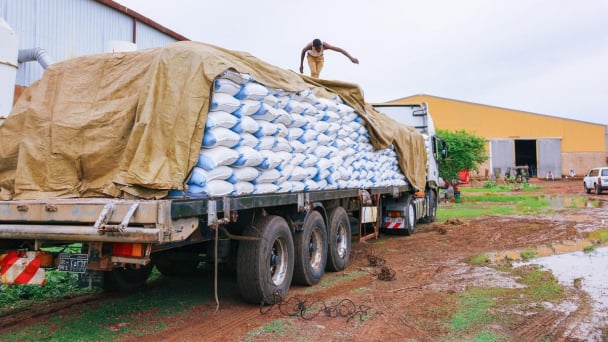
(VAN) In 2024, over 295 million people across 53 countries and territories faced acute hunger—an increase of almost 14 million people compared to 2023, while the number of people facing catastrophic levels of hunger reached a record high.
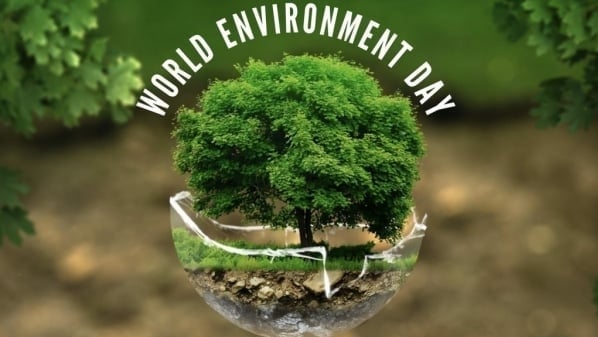
(VAN) World Environment Day 2025 (June 5) carries the theme 'Beat Plastic Pollution' continuing to emphasize the global urgency of addressing the plastic waste crisis.
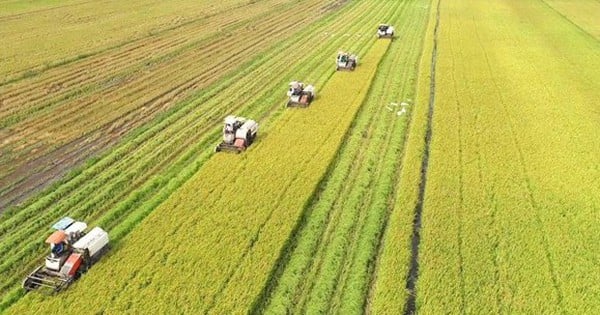
(VAN) This was the assessment shared by experts at the workshop titled 'Assessing the Role and Potential of Low-Emission Rice Production Systems in Vietnam,' held on the morning of May 19.

(VAN) Cai Rong Port is the fisheries control center of Quang Ninh, helping to monitor fishing vessels, combat IUU fishing, and remove the EC's 'yellow card'.
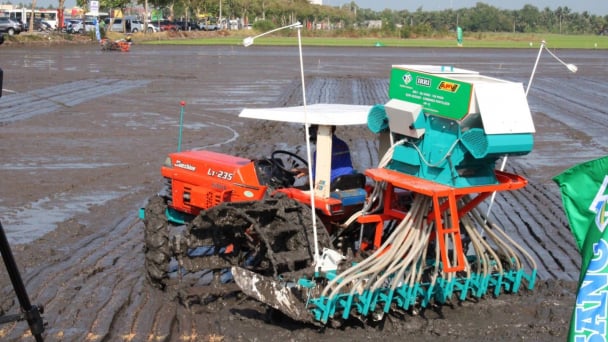
(VAN) The German Agricultural Society (DLG) explores the possibility of establishing a mechanization service center in Vietnam’s Mekong Delta to support farmers in accessing and utilizing advanced machinery.

(VAN) On May 16, the Department of Water Resources Management, in collaboration with the Food and Agriculture Organization of the United Nations (FAO), held a signing ceremony for the GEF-8 project document.

(VAN) Food safety, mechanization, vocational training, and market opening are key areas of cooperation expected between the Vietnamese Government and the Federal Republic of Germany.